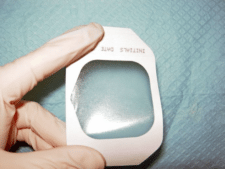The Continuum of Wound Dressings- Semipermeable Film Dressings
As you know, there are more than 3000 wound care products available on the market, which can make it very confusing for practitioners to choose the correct wound care product for their clients’ wounds. Let’s continue our discussion on the continuum of wound dressings.
Semipermeable Film Dressings
These dressings are thin and flexible and are composed of a transparent polyurethane material. They have an adhesive backing which enables them to adhere to the skin without damaging the skin or the wound bed. Semipermeable film dressings are permeable to oxygen and carbon dioxide, as well as water vapour, but do not allow bacteria and water to pass through. These dressings are incapable of absorbing much moisture. Typically, fluid will gather beneath the dressing- this fluid is not a sign of infection. These dressings allow the clinician to view the wound bed as it is healing, but the accumulation of fluid will sometimes obscure the wound bed. These dressings are able to stretch and conform to virtually any body area and come in a variety of sizes. It should be noted that these dressings do not insulate the wound very well. Film dressings should be secured to intact skin and may be left in place for 5 to 7 days. These dressings should not be used on wounds with heavy drainage and should not be applied to patients with frail skin.
Indications
Semipermeable film dressings are typically used on lacerations, abrasions, skin tears and other superficial wounds. They can also be used to cover sutured wounds, graft sites and partial thickness wounds. They may also be used where there are areas of friction to decrease shearing forces between the dressing and the support surface. Because they are waterproof, they may be used to cover wounds and intravenous catheter sites to allow bathing; they may be also be used to cover wounds for ultrasound treatment.
Precautions
A skin-protecting agent should be applied to intact skin that will be covered by a semipermeable film dressing to prevent maceration. A good edge seal is required to prevent bacteria from getting into the wound. These dressings will not adhere if the skin is wet or oily. Should the film dressing edge begin to separate from the skin you can simply trim it, providing that the wound bed is covered. These dressings should not be used on infected wounds.
If you are enjoying this series on wound care products, you may consider becoming certified as a wound care professional. Wound Educators is the premier online wound education site, preparing professionals to become nationally certified. If you would like to learn more about becoming a certified wound care professional, please contact us.
Sources
Meyers, B (2008). Wound Management: Principles and Practice. 2nd edition. Pearson Prentice Hall. Upper Saddle River, New Jersey. pg. 128-130.
Wound dressings- acute traumatic wounds. The Royal Children’s Hospital Melbourne. https://www.rch.org.au/clinicalguide/guideline_index/Wound_dressings_acute_traumatic_wounds/


Thank you very much such an informative article. I looked for this information for days until all my questions were answered in just this one article. Once again, thank you.
This blog post on semipermeable film dressings is incredibly insightful! I never realized how versatile and beneficial these waterproof wound products are. It’s great to learn how they help in promoting healing while keeping the wound protected from external contaminants. Definitely looking to try these for my next first aid kit!
I found this post incredibly informative! The benefits of semipermeable film dressings for wound care are so clear now. It’s great to see how these waterproof products can promote healing while keeping the wound protected. Thanks for sharing such detailed insights!
Great insights on semipermeable film dressings! I’ve been looking for effective waterproof options for my post-surgery care, and your breakdown of their benefits really helps. It’s nice to see detailed information on how they can enhance healing while keeping the area protected. Thanks for sharing!
This post really opened my eyes to the benefits of semipermeable film dressings! I had no idea how effective they were for keeping wounds protected while still allowing for moisture balance. The waterproof feature is especially appealing for my active lifestyle. Thanks for sharing such detailed insights!